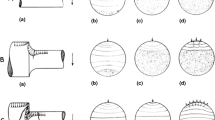Abstract
The often cited “Charles–Hillig” model of delayed failure assumes that corrosive attack on existing flaws in glass is controlled by interactions involving the moisture in the environment, which leads to time and stress dependent failure. The analysis by Inglis of the stress multiplication at a rounded end of a flaw is combined with stress-dependent chemical kinetics and thermodynamics. Failure occurs when the tip stress reaches the ultimate strength of the glass. The model provides a physical interpretation of the empirical “Universal Fatigue Law.” When sufficient data is available, it also provides an algorithm that allows a precise determination of the minimum stress needed to induce time-dependent failure. This model is compared with the competing LEFM model.
Similar content being viewed by others
References
Y. Bando S. Ito M. Tomozawa (1984) ArticleTitleDirect observation of crack tip geometry of SiO2 glass by high-resolution electron microscopy ibid 67 IssueID3 C-36–37
R.J. Charles (1958a) ArticleTitleStatic fatigue of glass Journal of the Applied Physics 19 IssueID11 1554–1560 Occurrence Handle10.1063/1.1722992 Occurrence Handle1958JAP....29.1554C
Charles, R.J. (1958b). In: Progress in Ceramic Science, (edited by Burke, J.E.) Vol.1, Pergamon Press, Oxford, pp. 1–38.
Charles, R.J. and Hillig, W.B. (1962). The kinetics of glass failure by stress corrosion, In: Symposium on Mechanical Strength of Glass and Ways of Improving It, Florence, Italy, September 25–29, 1961, Union Scientific Continental du Verre, Charleroi, Belgium.
T.-J. Chuang E.R. Fuller (1992) ArticleTitleExtended charles–hillig theory for stress corrosion cracking of glass Journal of American Ceramic Society 75 IssueID3 540–545 Occurrence Handle10.1111/j.1151-2916.1992.tb07839.x
F. Cleri S.R. Philpot D. Wolf S. Yip (1998) ArticleTitleAtomistic simulations of materials fracture and the link between atomic and continuum length scales Journal of American Ceramic Society 81 IssueID3 501–516 Occurrence Handle10.1111/j.1151-2916.1998.tb02368.x
Doremus, R.H. (1985). Fatigue in glass. In: Strength of Inorganic Glass, (edited by Kurkjian C.R.). Plenum Press, New York, pp. 231–242
S. Glasstone K.J. Laidler H. Eyring (1941) The Theory of Rate Processes McGraw-Hill New York
Griffith, A.A. (1920). The phenomena of rupture and flow in solids. Transition Royal Society (London), Phililipines Transitation, Royal Society (London), A221, 163.
J-P Guin S.M. Weiderhorn T. Fett (2005) ArticleTitleCrack tip structure in soda-lime-silicate glass Journal of American Society 88 IssueID3 652–659
W-T Han M. Tomozawa (1990) ArticleTitleCrack initiation and mechanical fatigue of silica glass Journal of Non-Crystals Solids 122 90–100 Occurrence Handle10.1016/0022-3093(90)90230-J Occurrence Handle1990JNCS..122...90H
Hillig, W.B. and Charles, R.J. (1965). Surfaces, stress-dependent reactions, and strength. In: High Strength Solids (edited by Zackay V.F.) Wiley, New York, pp. 682–705.
C.E. Inglis (1913) ArticleTitleStresses in a plate due to the presence of cracks and sharp corners Proceedings Institute Naval Architects 55 210
K. Jakus J.E. Ritter SuffixJr. J.M. Sullivan (1981) ArticleTitleDependency of fatigue predictions of the form of the crack velocity equation Journal of American Ceramic Society 64 IssueID6 372–374 Occurrence Handle10.1111/j.1151-2916.1981.tb10305.x
B.R. Lawn (1993) Fracture of Brittle Solids EditionNumber2 Cambridge University Press London
Michalske, T.A. (1983). The stress corrosion limit: its measurement and implications. In: Fracture Mechanics of Ceramics, (edited by Bradt, R.C, Evans, A.G., Hasselman, D.P.H. and Lange, F.F.) Vol. 5, Plenum Press, New York, pp. 277–289.
Mould, R.E. and Southwick, R.D., (1959). Static fatigue of abraded glass under controlled ambient conditions, I–IV. Journal of American Ceramic Society I, 42(11), 542–547; II,42(12), 582–592(1959); III, 43(3), 160–167 (1960); IV, 44(10), 481–491(1961).
Muschelivili N.I. (1956). Foundations of Mathematical Elasticity Theory (transl.) as quoted. In: Spannungserhoehung am Rande von Loechern , (edited by Sawin G.N.), VEB Verlag, Technik Berlin, pp. 167.
J.E. Ritter SuffixJr. C.L. Sherburne (1971) ArticleTitleDynamic and static fatigue of silicate glasses ibid 54 IssueID12 601–605
Tang, Z., Bower, A.F. and Chuang, T-J. (2000). Numerical simulations of subcritical crack growth by stress corrosion in an elastic solid. Multi-scale Deformation and Fracture in Materials and Structures. (edited by Chuang T.-J. and Rudnicki, J.) Kluwer, Dordrecht, pp. 331–348.
M. Tomazawa (1996) ArticleTitleFracture of glasses Annuals Review Materials Science 16 43–74 Occurrence Handle10.1146/annurev.ms.26.080196.000355 Occurrence Handle1996AnRMS..26...43T
Wiederhorn S.M. (1965). Effect of environment on the fracture of glass. National Bureau of Standards Report 8901, U.S.Department of Commerce.
S.M. Wiederhorn (1967) ArticleTitleInfluence of water vapor on crack propagation in soda-lime glass Journal of American Ceramic Society 50 IssueID8 407–414 Occurrence Handle10.1111/j.1151-2916.1967.tb15145.x
S.M. Wiederhorn L.H. Bolz (1970) ArticleTitleStress corrosion and static fatigue of glass ibid 53 IssueID10 543–548
S.M. Weiderhorn A. Dretzke J. Rödel (2002) ArticleTitleCrack growth of soda-lime-silicate glass near the static fatigue limit ibid 85 IssueID9 2287–2292
B.J.S. Wilkins R. Dutton (1976) ArticleTitleStatic fatigue limit with particular reference to glass Journal of American Ceramic Society 59 IssueID3–4 108–112 Occurrence Handle10.1111/j.1151-2916.1976.tb09442.x
Author information
Authors and Affiliations
Rights and permissions
About this article
Cite this article
Hillig, W.B. The C-H delayed failure mechanism revisited. Int J Fract 139, 197–211 (2006). https://doi.org/10.1007/s10704-006-0025-3
Received:
Accepted:
Issue Date:
DOI: https://doi.org/10.1007/s10704-006-0025-3




